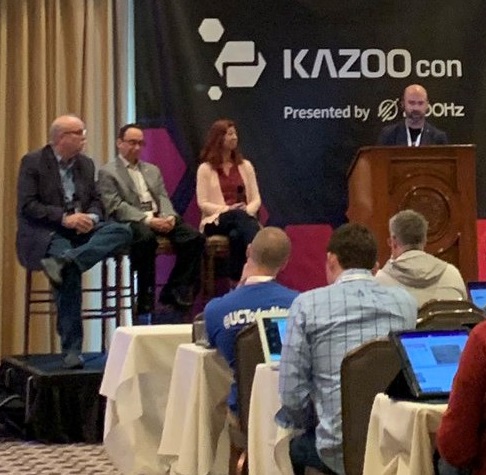Mavenir Analyst Event -- Mobile Native UCaaS
From the colonies to Mother England, London was the next stop. Mavenir isn’t a household name, but it competes squarely with Nokia, Ericsson, and -- there it is again -- Huawei. Wireless is a secondary focus for me, but when it comes to 5G, LTE, NFV, etc., Mavenir has a good story. As these technologies mature, wireless operators will have a stronger value proposition for enterprises, and I like how Mavenir talks about helping carriers not just with cost reduction, but also for revenue protection and revenue generation.
Mavenir talked a lot about these technologies, and how it helps carriers move on from legacy infrastructure to cloud. I’m not strong on the details of wireless network technologies, and what resonated more for me was its messaging around cloud economics. Mavenir presented several examples of how it helps carriers support new applications and find new ways to monetize voice and messaging services.
UCaaS, part of its Mobile Business portfolio, is one of its growth “vectors.” Mavenir has a clear focus on SMBs, for which the pain point is trying to manage a disjointed mix of fixed-line and mobile communications applications. The scenario is familiar, and building on its strong position for Rich Communications Services messaging, it can offer a complete UC&C white-label solution for mobile network operators. Its view is that cloud-based platforms like this give operators the fastest way to scale and not just keep their end customers, but offer a new set of mobile-centric services to drive growth.
2600Hz’s KAZOOcon -- Mobile Native Apps, American-Style
Final stop -- San Diego -- going east to west now, this was my first time attending 2600Hz’s event, which brings together thought leaders to explore the latest technologies and strategies in UC. Aside from attending sessions, along with my BCStrategies colleagues Blair Pleasant and Phil Edholm I participated in an analyst panel about the state of UC (for a longer look at KAZOOcon, read
Blair’s review on BCStrategies.com).
As with Mavenir, 2600Hz offers turnkey cloud-based VoIP and UC services primarily to SMBs. Another similarity is mobility, where it partners with T-Mobile for wireless SMB offerings.
5G could turn out to be a boon for UCaaS, especially when considering how prevalent DSL still is in smaller markets. We heard this during a presentation from VoIP provider Ooma -- yes, even Ooma is selling UC now -- and it’s a good reality check for those who think that the U.S. is blanketed with blazing fast broadband.
To be fair, mobility has long been a weak link for UC, so there’s no guarantee that the apps will work just as well as on a PC, and the adoption rate of mobile UC features has been poor. Furthermore, many UC apps aren’t being held back because of wireless network constraints -- end users just don’t see the utility or aren’t even made aware of these capabilities. 5G should help fix some of these problems, and 2600Hz seems to be betting on exactly that. The point here being that in locations where fixed-line broadband isn’t great, 5G will open the UC market in these instances.
Getting channels to sell mobile UCaaS isn’t a sure thing either -- even with a major brand like T-Mobile -- but at least this gives 2600Hz something more compelling to sell than SIP trunking or phone systems. However, channels will have to go a bit out of their comfort zone to be successful with mobility, and based on the Q&A during our panel, I’d say i they have a fair way to go.
KAZOOcon is a developer-heavy event, and the cargo shorts, flip flops, and surfer vibe reflect a different audience than what we usually see at vendor events. I’ll be at Twilio Signal next month, where that vibe will be on steroids, and in my book, it remains to be seen how much revenue developers can really drive, especially when going upmarket from SMBs. That said, for 2600Hz, those developers are the innovation engine, and company co-founder Patrick Sullivan did a good job explaining how the company’s distributed architecture enables that.
2600Hz certainly seems to be on the right track to help SMBs get beyond the desk phone with cloud -- and make it easy for channels to sell it -- but end customers are still a step behind all this. In that regard, this sounds like MISA redux, and is a reminder that not all end markets are created equal, and that desk phones are going to be around for a while yet.
Jon is writing on behalf of BCStrategies, an industry resource for enterprises, vendors, system integrators, and anyone interested in the growing business communications arena. A supplier of objective information on business communications, BCStrategies is supported by an alliance of leading communication industry advisors, analysts, and consultants who have worked in the various segments of the dynamic business communications market.










